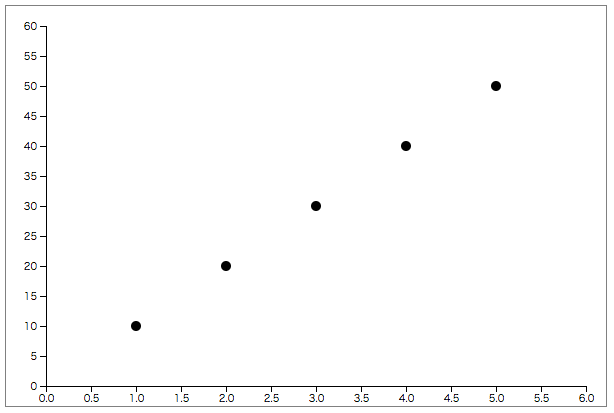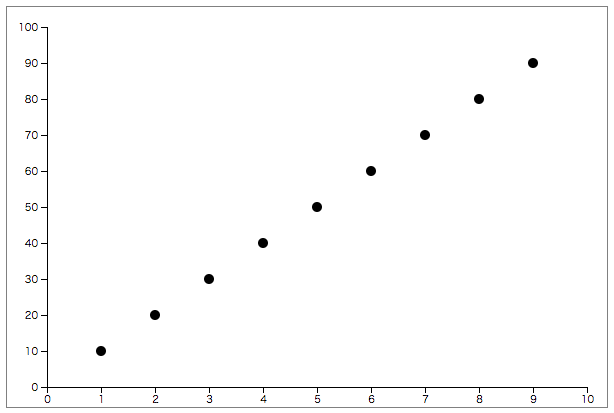はじめに
D3.jsを勉強し始めたのですが、まだまだv4に対応した日本語の書籍や情報などは少ないようです(2017年5月現在)。
シンプルな散布図を作ろうとしたのですが、ちょうどいいサンプルコードが見つからなかったので自分が作ったものを載せてみます。
目標
- 散布図(Scatter Plot)を作成する。
- データの追加と削除を行う。
- 軸をデータに合わせて自動調整する。
- プロットと軸の状態はtransitionで遷移させる。
初期状態
データを追加した状態
サンプルコード
デモページ
htmlファイルをローカルに置いても動作します。
以下の問題がありますが、コードをシンプルにするために対策はしていません。
- データの追加時にも、削除のtransitionの待ち時間が発生します。
- 描画中にデータの追加・削除を行うと、プロットが正常に描画されません。
scatter-plot.html
<!DOCTYPE html>
<html>
<head>
<meta charset="utf-8">
<title>Scatter Plot</title>
<style>
svg {
border: solid 1px gray;
}
</style>
<script src="https://d3js.org/d3.v4.min.js"></script>
</head>
<body>
<!-- グラフを描画するsvg -->
<svg></svg>
<div>
<button onclick="addData()">追加</button>
<button onclick="deleteData()">削除</button>
</div>
<script>
// ==================== メインルーチン ==================== //
var data = [
{ x: 1, y: 10 },
{ x: 2, y: 20 },
{ x: 3, y: 30 },
{ x: 4, y: 40 },
{ x: 5, y: 50 }
];
var svgWidth = 600; // svg要素の幅
var svgHeight = 400; // svg要素の高さ
var margin = {top: 20, right: 20, bottom: 20, left: 40}; // マージン
var width = svgWidth - margin.left - margin.right; // グラフエリアの幅
var height = svgHeight - margin.top - margin.bottom; // グラフエリアの高さ
var t1, t2, t3; // transition用変数(t1:プロット削除, t2:スケール遷移, t3:プロット追加)
var scale = {}; // スケール用変数
// ----- SVG要素の設定 ----- //
var svg = d3.select("svg")
.attr('width', svgWidth)
.attr('height', svgHeight);
// ----- グラフエリアの設定 ----- //
var g = svg.append('g')
.attr('transform', translate(margin.left, margin.top));
// ----- 初期データの表示 ----- //
setScale();
initializeAxis();
initializePlot();
// ==================== 関数定義 ==================== //
// ----- プロットの初期設定 ----- //
function initializePlot() {
var plot = g.selectAll('circle')
.data(data)
.enter()
.append('circle')
.attr('cx', function(d) { return scale.x(d.x) })
.attr('cy', function(d) { return scale.y(d.y) })
.attr('r', 5);
}
// ----- プロットのアップデート ----- //
function updatePlot() {
// データのバインド
var plot = g.selectAll('circle')
.data(data);
// 削除されたデータのプロットを削除
plot.exit()
.transition(t1)
.attr('r', 0)
.remove();
// 既存のデータのプロットはスケールの変更に合わせて位置を変更
plot.transition(t2)
.attr('cx', function(d) { return scale.x(d.x) })
.attr('cy', function(d) { return scale.y(d.y) });
// 新規データのプロットを追加
plot.enter()
.append('circle')
.attr('cx', function(d) { return scale.x(d.x) })
.attr('cy', function(d) { return scale.y(d.y) })
.attr('r', 0)
.transition(t3)
.attr('r', 5);
}
// ----- スケールの設定 ----- //
function setScale() {
// X軸
var xRangeMin = 0;
var xRangeMax = d3.max(data, function(d) { return d.x; }) + 1;
scale.x = d3.scaleLinear()
.domain([xRangeMin, xRangeMax])
.range([0, width]);
// Y軸
var yRangeMin = 0;
var yRangeMax = d3.max(data, function(d) { return d.y; }) + 10;
scale.y = d3.scaleLinear()
.domain([yRangeMin, yRangeMax])
.range([height, 0]);
}
// ----- 軸の初期設定 ----- //
function initializeAxis() {
// X軸
svg.append('g')
.attr('class', "x_axis")
.attr('transform', translate(margin.left, height + margin.top))
.call(d3.axisBottom(scale.x));
// Y軸
svg.append('g')
.attr('class', "y_axis")
.attr('transform', translate(margin.left, margin.top))
.call(d3.axisLeft(scale.y));
}
// ----- 軸の再設定 ----- //
function resetAxis() {
// X軸
svg.select(".x_axis")
.transition(t2)
.call(d3.axisBottom(scale.x));
// Y軸
svg.select(".y_axis")
.transition(t2)
.call(d3.axisLeft(scale.y));
}
// ----- transitionの設定(delayで調整) ----- //
function setTransition() {
t1 = d3.transition()
.duration(500);
t2 = d3.transition()
.duration(1000)
.delay(500);
t3 = d3.transition()
.duration(500)
.delay(1000);
}
/*
// ----- transitionの設定(チェーンで調整) ----- //
function setTransition() {
t1 = d3.transition()
.duration(500);
t2 = t1.transition()
.duration(1000);
t3 = t2.transition()
.duration(500);
}
*/
// ----- translate用の文字列を作成 ----- //
function translate(x, y) {
return 'translate(' + x + ',' + y + ')';
}
// ----- データの追加 ----- //
function addData() {
if (data.length >= 10) {
return;
}
data.push({
x: data.length + 1,
y: (data.length + 1) * 10
});
setTransition();
setScale();
resetAxis();
updatePlot();
}
// ----- データの削除 ----- //
function deleteData() {
if (data.length == 0) {
return;
}
data.pop();
setTransition();
setScale();
resetAxis();
updatePlot();
}
</script>
</body>
</html>
参考
D3 Tips and Tricks v4.x
GitHub - d3/d3-transition:Animated transitions for D3 selections.
General Update Pattern, III
Chained Transitions

